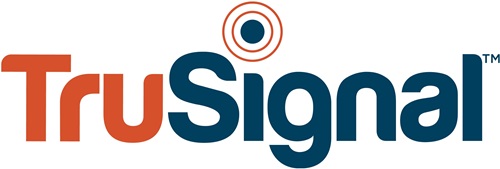Tell us about your role and how you got here? What inspired you to start a people-based marketing company?
When I was head of marketing for NextCard (a credit card originator from the Internet 1.0 era), I saw firsthand how using data and individually tailored offers made a huge difference in ROI and customer satisfaction. Unfortunately, the sophisticated data and analytical tools available for credit decisioning were just not available for digital marketing at the time. My team had to buy media based on site context, or the composite audience of a website. I was inspired to start TruSignal, Inc. so that we could take the sophisticated people-based data and predictive modeling capabilities of the financial services industry and adapt them for a 1:1 addressable digital world.
Back in 2012, while working at eBureau, a predictive analytics company doing lead scoring and fraud detection, I had my chance to incubate an early version of TruSignal by borrowing some of the assets of eBureau. At the time, audience onboarding was just getting off the ground and DSPs were making it possible to target specific people regardless of which website(s) they happen to be visiting. So all the pieces of the 1:1 people-based marketing opportunity were there, but it was still a few more years before the industry matured and reached the critical mass to make the vision a reality. In 2017, eBureau was acquired by TransUnion and we decided to spin out TruSignal as a stand-alone company. So while “people-based marketing” and “machine-learning” are suddenly hot topics in the industry, we have been executing on that promise for a long time and becoming the very best at developing highly accurate, people-based lookalikes to power digital marketing.
What are the core tenets of TruSignal’s predictive scoring engine for audience expansion?
TruSignal is all about offline data—using our access to proprietary offline data sources that are not otherwise available on the exchanges. That offline data enables us to assign a score to most US adults. We score each of them individually, based on addressable profiles. The quality of this proprietary data differentiates our scoring, making it much more precise than the alternatives.
While the quality of the offline data is important, the speed and transparency of the modeling is a key aspect as well. We are also a digital-first company, so all of our data handling and audience distribution is designed to work seamlessly in the modern digital age that includes cookies, mobile ad IDs, hashed emails, et cetera.
What are the pain points for marketers in leveraging predictive analytics for better marketing intelligence?
We see that ease-of-access, or lack thereof, is a major pain point for marketers. We’ve worked hard for the past two years to reduce the friction that marketers can encounter when they work with separate vendors. As part of that, we’ve pursued direct integrations with many DSPs and onboarding companies. For example, we have an integration with LiveRamp in which a marketer can onboard a CRM file, and can then order up a TruSignal audience right away. A number of services white-label our audiences, and that’s great.
Moreover, our self-serve solution, the TruAudience Platform, reduces that friction by providing audience management, predictive modeling and consumer insights directly to marketers. The platform has five modules that allow for the deployment of custom audiences to demand-side platforms, data-management platforms, and media partners, as well as across a variety of channels and devices, including TV, radio, mobile, social, native and desktop.
How should CMOs plan to adopt audience data platforms to improve targeting?
The challenge that the CMO faces around audience targeting today is deciphering between the number of solution vendors in the ecosystem, understanding their differences and the end-benefit provided. For many marketers, that means choosing one segment from a group of 50,000 that all sound the same. These types of pre-built solutions only target based on a few generic attributes—gender, income, age, and education. They assume everyone in those segments are equally valuable. Marketers are forced to overlap these segments to try to increase the targeting accuracy, a piecemeal approach that degrades scale significantly. Instead of picking from these pre-built solutions that carry such high tradeoffs, we’re seeing marketers adapt more custom solutions for targeting. Using first-party data and modeling to build custom audiences from the ground up helps marketers target valuable consumers based on the analysis of thousands of attributes, without sacrificing accuracy or scale. As this trend grows, so do the number of companies claiming to offer “custom” solutions. Marketers must be wary about vendors selling pre-built solutions disguised as custom. Be sure to ask questions about the type of data used and for details about the modeling process. A good partner should be able to explain the process to you openly and answer any questions about data, modeling, and customization.
What tools does your marketing stack consist of in 2017? How do you measure your martech stack’s performance?
We begin by asking marketers what their objectives are. Some are focused on new customer acquisition, some more on retention. Some like the top of the funnel, while some prefer the bottom of the funnel.
Ultimately, every marketer wants to convert more people at a lower cost. Let’s take the example of a financial services client we’ve worked with that was trying to target prospects interested in mortgage lending, including refinance and purchase products. We used predictive modeling to determine who was likely and who was unlikely to convert. With our help, the client increased conversions dramatically and reduced the costs of acquisition.
We want to focus on actual people. We build an audience by matching marketers’ CRM data with offline records in an integrated, easy-to-use way. TruSignal is not another standalone solution that marketers have to deal with—rather, we’re integrated with a lot of platforms, and streamlined into a service offering, making us increasingly turnkey for marketers, which is important.
What startups are you watching/keen on right now?
SafeGraph (Auren Hoffman) collects mobile-location data tied to device. Instead of trying to maximize the quantity of mobile data, they are focused on the accuracy. Ultimately, our ability to be successful relies on the quality of input data. So while many other location companies are busy chasing scale (and sacrificing accuracy to get it), it’s our understanding that SafeGraph is meticulously focused on the data quality. As cookies continue to crumble, accurate mobile data is becoming the preferred digital identity currency.
I’m also watching a company called Beeswax (Ari Paparo), which is a bidder-as-a-service solution that enables brands and agencies to control all aspects of programmatic bidding. Data in the ecosystem has been used predominantly for targeting, but there are very important use cases for data related to creative targeting and bid pricing optimization. Without companies like Beeswax, brands are at the mercy of the functionality of their DSP. Beeswax makes it possible for companies to take complete control of their DSP stack and develop innovations that create a competitive advantage.
Would you tell us about your standout digital campaign?
We worked with a leading online retailer who came to us for help identifying which of its 18 million monthly uniques might be ready to buy a high-priced handbag. By applying our scoring system to the retailer’s audience, we increased conversions 200%, even as we lowered their costs per action by 60%. We’re certainly pleased to be able to bring our clients that kind of success.
As a technology leader, how do you prepare for an AI-driven ecosystem?
At TruSignal, we develop technology that uses AI. There is so much hype in the industry now that it’s important to separate the companies that are using the tech thoughtfully, versus just riding the buzz. Separating the hype from the bona fide offers requires education, so I spend a fair amount of time reading about and learning the vocabulary of machine-learning and AI. This gives me enough background information to ask more informed questions and helps me separate the buzz from the breakthrough. I also focus on understanding and categorizing different kinds of data. Ultimately, AI requires good data to be effective—the best algorithm in the world cannot solve problems if the right data is unavailable or very inaccurate.
One word that best describes how you work.
Collaboratively.
What apps/software/tools can’t you live without?
Slack.
What’s your smartest work related shortcut or productivity hack?
Sharing my calendar availabilities with others via Google Calendars. Turns out you can send a hyperlink that shows all of your availabilities to a 3rd party and they can figure out a time that works for them for meetings.
What are you currently reading?
Stumbling on Happiness by Daniel Gilbert. I usually consume data on tablets, the web, and my Kindle.
What’s the best advice you’ve ever received?
Figure out what you can be the best at and focus on nailing that.
Tag the one person in the industry whose answers to these questions you would love to read:
Thank you David! That was fun and hope to see you back on MarTech Series soon.
Experienced, executive professional with deep experience in Internet customer acquisition, productdevelopment, and marketing analytics.

TruSignal, Inc. is a leader in Predictive Score Marketing technology, empowering and serving leading platforms and agencies. TruSignal uses people-based offline data, predictive scoring and cross-channel ID matching to deliver a more advanced end-to-end modeling solution for platforms and agencies to enhance existing solutions that help marketers and advertisers more effectively target the right people and pay the right price for every impression for measurable business growth across marketing initiatives.
The MTS Martech Interview Series is a fun Q&A style chat which we really enjoy doing with martech leaders. With inspiration from Lifehacker’s How I work interviews, the MarTech Series Interviews follows a two part format On Marketing Technology, and This Is How I Work. The format was chosen because when we decided to start an interview series with the biggest and brightest minds in martech – we wanted to get insight into two areas … one – their ideas on marketing tech and two – insights into the philosophy and methods that make these leaders tick.



